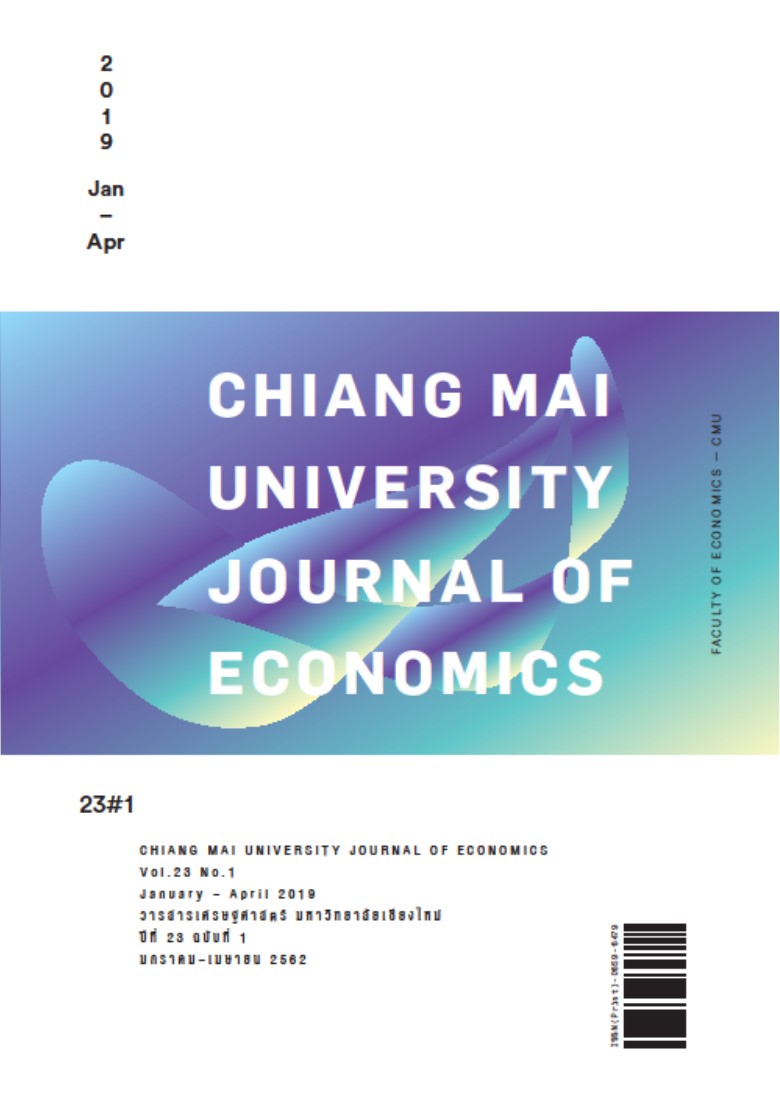Modeling and the Hedging Effectiveness of Hedge Ratios for Rubber Price in Thailand
Keywords:
Hedge ratio, Rubber Price, ThailandAbstract
This paper investigates the optimal hedge ratio and compares the effective of the hedging in both time varying and constant hedge ratio by using the data of the Ribbed Smoked Sheet No. 3 (RSS3). Daily data from October 26, 2016 to September 28, 2018, weekly data from June 4, 2004 to September 28, 2018, and monthly data from June 2004 - September 2018 are employed. Time varying hedge ratios estimated by Bivariate GARCH model, Bivariate Diagonal BEKK GARCH model, Bivariate GARCH-X model, and CCC model which assume the error term has normal distribution and t- distribution. Whereas the constant hedge ratios estimated by OLS model, VAR model, and VECM model.
The results found that the hedge ratios from daily data are in range 0.1568 – 0.4108 and Bivariate Diagonal BEKK GARCH model with the error term has t-distribution is the best effective. Using weekly data, the hedge ratios are lie between 0.5974 – 0.7534 and VECM model is the best effective. For monthly data, the hedge ratios are in range 0.7415 – 0.8910 and Bivariate GARCH-X model with the error term has t-distribution is the best effective.
References
Chotinuchittrakul, V. & Boonvorachote, T. (2013). “Optimal Hedge Ratio Estimations and Hedging Effectiveness: A Case Study of Thailand’s Commodity Futures Exchange”. Thai Journal of Operations Reseach 1(1) (January – June 2013), pp. 16-24.
Choudhry, T. (2003). “Short-run deviations and optimal hedge ratio: evidence from stock futures”. Journal of multinational financial management 13, pp. 171 – 192.
¬________. (2004). “The hedging effectiveness of constant and time-varying hedge ratios using three Pacific Basin Stock Futures”. International Review of Economics and Finance 13, pp. 371-385.
________. (2009). “Short-run deviations and time-varying hedge ratios: Evidence from agricultural futures markets”. International Review of Financial Analysis 18, pp. 58 - 65.
Chuavallee, P. & Pisitsupakul, K. (2014). “Why the price of rubber is down? And sustainable solutions”. Bank of Thailand. https://www.bot.or.th/Thai/ResearchAndPublications/DocLib_/
Article_02_09_14.pdf. (In Thai)
Conroy, R. M. (2003). “Hedging with Forwards and Futures”. The University of Virginia Darden School Foundation. 11 pages.
Ederington, L.H. (1979). “The hedging performance of the new futures markets”. Journal of Finance 1, pp. 157 – 170.
Engle, R., & Kroner, K. (1995). “Multivariate simultaneous generalized ARCH”. Econometric Theory 11, pp. 122−150.
Hou, Y. & Li, S. (2013). “Hedging performance of Chinese stock index futures: A empirical analysis using wavelet analysis and flexible bivariate GARCH approaches”. Pacific-Basin Finance Journal 24, pp. 109-131.
Johnson, L.L. (1960). “The theory of hedging and speculation in commodity futures”. The Review of Economic Studies 3, pp. 139 – 151.
Kavussanos, M.G. & Nomikos, N.K. (2000). “Constant vs. time-varying hedge ratios and hedging efficiency in the BIFFEX market”. Transportation Research Part E 36, pp. 229-248.
Laws, J. & Thompson, J. (2005). “Hedging effectiveness of Stock index futures”. European Journal of Operational Research 163, pp. 177-191.
Lee, T. (1994). “Spread and volatility in spot and forward exchange rates”. Journal of International Money and Finance 13, pp. 375−383.
McMillan, D. (2005). “Time-varying hedge ratios for non-ferrous metals prices”. Resources Policy 30, pp. 186 – 193.
Pelletier, D. (2006). “Hedging Using Futures”. North Carolina State University, 17 pages.
Pok, W.C., Poshakwale, S.S. & Ford, J.L. (2009). “Stock index futures hedging in the emerging Malaysian market”. Global Finance Journal 20, pp. 273-288.
Rawangsuk, P. (2011). “Rubber price trends in 2011”. Focused and quick (FAQ) Issue 29. https://www.ryt9.com/s/bot/1497781. (In Thai)
Thailand Futures Exchange (2015). “RSS3 Futures”. https://www.tfex.co.th/th/education/others.html. (In Thai)
Thairath online (2017). “Looking back on the price of rubber around 10 years, compared to the price of 3 governments”. https://www.thairath.co.th/content/1124949. (In Thai)
The Agricultural Futures Exchange of Thailand. (2013). “Introduce Organization”. https://www.afet.or.th/v081/thai/corporate/introduction.php.
Sucharitkul, R. (2015). “All Together ... strong”. Bangkokbiznews 22 October 2015. https://www.sec.or.th/TH/Documents/Information/Interviews-Articles/bangkok_221058.pdf
Yao, Z. & Wu, H. (2012). “Financial Engineering Estimation of Minimum Risk Hedge Ratio”. Systems Engineering Procedia 3, pp. 187 – 193.
Zong, C.Q. et. al (2014). “Hedging Effectiveness of Rubber Market in Thailand”. Bachelor of Economics (Hons) Financial Economics, Malaysia, Universiti Tunku Abdul Rahman. 74 pages.
Downloads
Published
Issue
Section
License
All opinions and contents in the CMJE are the responsibility of the author(s). Chiang Mai University Journal of Economics reserves the copyright for all published materials. Papers may not be reproduced in any form without the written permission from Chiang Mai University Journal of Economics.
ข้อคิดเห็นที่ปรากฏและแสดงในเนื้อหาบทความต่างๆในวารสารเศรษฐศาสตร์มหาวิทยาลัยเชียงใหม่ ถือเป็นความเห็นและความรับผิดชอบโดยตรงของผู้เขียนบทความนั้นๆ มิใช่เป็นความเห็นและความรับผิดชอบใดๆของวารสารเศรษฐศาสตร์ มหาวิทยาลัยเชียงใหม่
บทความ เนื้อหา และข้อมูล ฯลฯ ในวารสารเศรษฐศาสตร์มหาวิทยาลัยเชียงใหม่ ถือเป็นลิขสิทธิ์เฉพาะของคณะเศรษฐศาสตร์มหาวิทยาลัยเชียงใหม่ หากบุคคลหรือหน่วยงานใดต้องการนำทั้งหมดหรือส่วนหนึ่งส่วนใดไปเผยแพร่ต่อหรือเพื่อกระทำการใดๆ จะต้องได้รับอนุญาตเป็นลายลักษณ์อักษร จากวารสารเศรษฐศาสตร์ มหาวิทยาลัยเชียงใหม่






